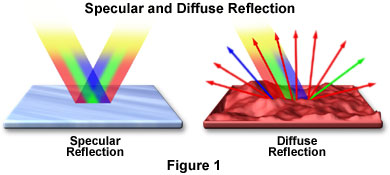Specular and Diffuse Reflection
Specular and Diffuse Reflection - Java Tutorial
The amount of light reflected by an object, and how it is reflected, is highly dependent upon the smoothness or texture of the surface. When surface imperfections are smaller than the wavelength of the incident light (as in the case of a mirror), virtually all of the light is reflected equally. However, in the real world most objects have convoluted surfaces that exhibit a diffuse reflection, with the incident light being reflected in all directions. This interactive tutorial explores how light waves are reflected by smooth and rough surfaces.
The tutorial initializes with a beam of white light (represented by a spectrum composed of all wavelengths between 400 and 700 nanometers) being reflected by a diffuse, or rough, red surface demonstrating Diffuse Reflection. In order to operate the tutorial, use the slider bars to adjust the color and texture of the surface appearing in the window between a range of zero (smooth) and 100 percent (maximum roughness). By translating the Surface Color slider, the color of the grid-laden surface is altered to produce corresponding changes in the wavelength spectrum of light reflected from the surface. When the slider labeled Surface Roughness is moved to the right, the texture of the surface becomes more irregular and light is reflected at a greater number of angles and wavelengths. Moving the slider to the left produces a progressive smoother surface. At the far left boundary of the Surface Roughness slider, the surface becomes totally flat and exhibits specular reflection of all incident wavelengths that match the color of the surface.
Most things that we see (people, cars, houses, animals, trees, etc.) do not themselves emit visible light but reflect incident natural sunlight and artificial light. For instance, an apple appears a shiny red color because it has a relatively smooth surface that reflects red light and absorbs other non-red (such as green, blue, and yellow) wavelengths of light. The reflection of light can be roughly categorized into two types of reflection: specular reflection is defined as light reflected from a smooth surface at a definite angle, and diffuse reflection, which is produced by rough surfaces that tend to reflect light in all directions (as illustrated in Figure 1). There are far more occurrences of diffuse reflection than specular reflection in our everyday environment.

To visualize the differences between specular and diffuse reflection, consider two very different surfaces: a smooth mirror and a rough reddish surface. The mirror reflects all of the components of white light (such as red, green, and blue wavelengths) almost equally and the reflected specular light follows the same angle from the normal, as does the incident light. The rough reddish surface, however, does not reflect all wavelengths because it absorbs most of the blue and green components, and reflects the red light. Also, the diffuse light that is reflected from the rough surface is scattered in all directions.
Perhaps the best example of specular reflection, which we encounter on a daily basis, is the mirror image produced by a household mirror that people might use many times a day to view their appearance. The mirror's smooth reflective glass surface renders a virtual image of the observer from the light that is reflected directly back into the eyes. This image is referred to as "virtual" because it does not actually exist (does not produce light) and appears to be behind the plane of the mirror due to an assumption that the brain naturally makes. The way in which this occurs is easiest to visualize when looking at the reflection of an object to one side of the observer, so that the light from the object strikes the mirror at an angle and is reflected at an equal angle to the viewer's eyes. As the eyes receive the reflected rays, the brain assumes that the light rays have reached the eyes in a direct straight path. Tracing the rays backward toward the mirror, the brain perceives an image that is positioned behind the mirror. An interesting feature of this reflection artifact is that the image of an object being observed appears to be the same distance behind the plane of the mirror as the actual object is in front of the mirror.
对不起,此内容在您的国家不适用。



